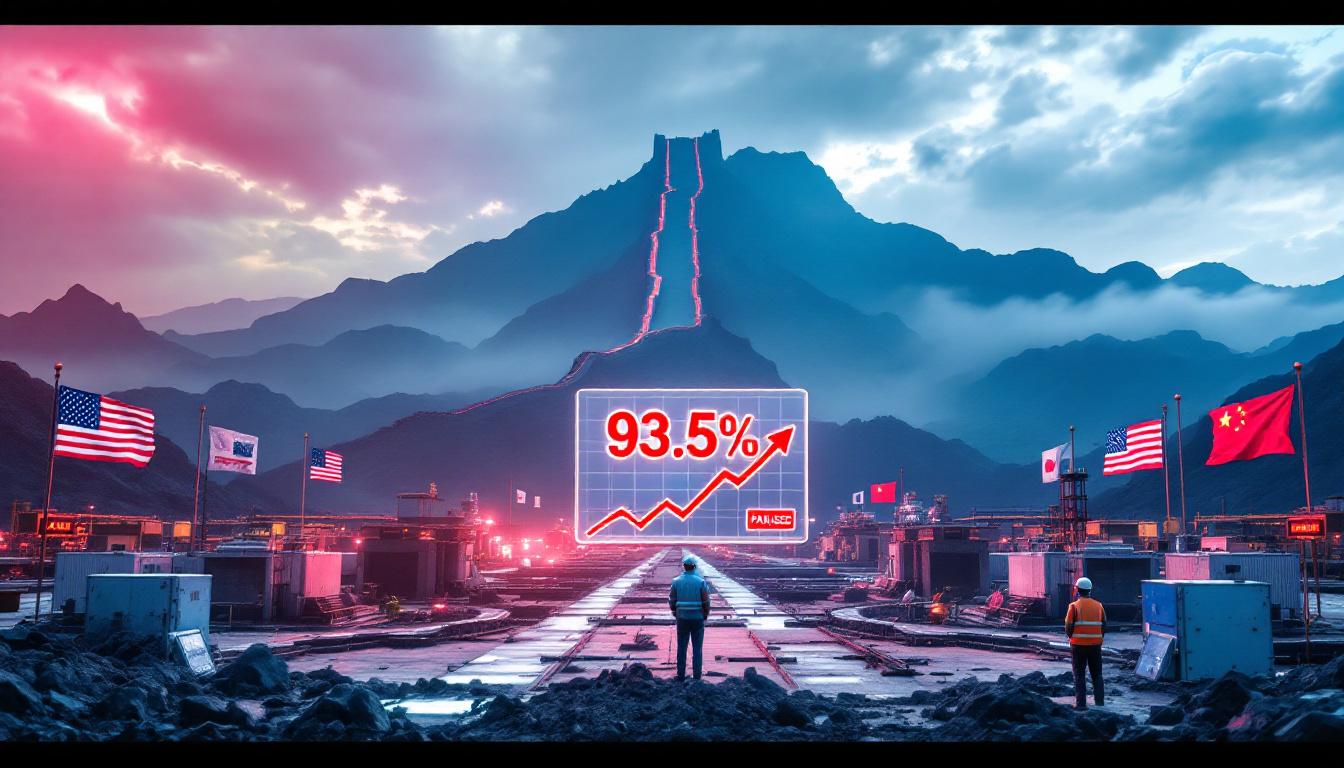The Naskapi Nation's Investment in Scandium: Implications for Indigenous Economic Development
The Naskapi Nation of Kawawachikamach has pioneered a transformative economic model by acquiring a 5% equity stake in Scandium Canada Ltd., marking a strategic shift from traditional resource royalty agreements to active ownership in critical mineral development. This C$334,000 investment in scandium by the Naskapi Nation, executed through the community-controlled Taasipitaakin Trust, positions the Naskapi as direct stakeholders in the Crater Lake scandium project—a deposit described as "the world's leading primary source of scandium." Unlike conventional arrangements that limited Indigenous communities to passive revenue streams, this equity partnership enables the Naskapi to influence corporate governance, benefit from long-term value appreciation, and participate in downstream processing opportunities. The transaction follows a year-long community engagement process involving Elders, youth groups, and leadership transitions, ensuring alignment with cultural values and sustainable development principles. By aligning with Quebec's aluminum production ecosystem and global demand for lightweight materials, this model demonstrates how Indigenous communities can leverage critical minerals strategy for generational wealth creation while advancing decarbonization goals through scandium-aluminum alloys.
Understanding the Naskapi Nation's Strategic Investment
Historical Context of Indigenous Resource Partnerships
Historically, Indigenous communities have been constrained by royalty-based agreements that offered limited financial returns and negligible influence over resource extraction projects on their traditional territories. These arrangements often lacked transparency and failed to align with long-term community development objectives, leaving nations vulnerable to market volatility and operator decisions.
Royalty structures typically capped benefits at 1–3% of gross revenue, providing minimal insulation against operational disruptions or commodity price fluctuations. This legacy created economic dependency without fostering skills transfer or equitable decision-making authority, perpetuating cycles of limited economic sovereignty.
The Evolution to Equity Participation
The Naskapi Nation's transition to equity ownership represents a deliberate departure from extractive models, facilitated through structured community consultations. Following an April 2024 pre-development agreement, the process paused during band-council elections, allowing newly elected leadership to evaluate technical and economic dimensions before ratification.
Community education initiatives detailed scandium's transformative properties and market potential, ensuring informed consent. The resulting 5% equity stake—secured through the Taasipitaakin Trust—provides direct corporate governance rights, including board representation influence and dividend entitlements. This structure mirrors the U.S. Department of Defense's direct investment in MP Materials Corp., validating equity participation as a strategic approach for critical mineral development.
What Makes Scandium a Strategic Critical Mineral?
The Transformative Properties of Scandium
Scandium's value derives from its unique capability to enhance aluminum alloys, achieving material properties unattainable through conventional metallurgy. When added at 0.1–0.5% concentration, scandium creates aluminum-scandium (Al-Sc) alloys exhibiting tensile strength comparable to titanium (exceeding 500 MPa), corrosion resistance surpassing stainless steel, and 15–20% weight reduction.
These alloys simultaneously improve electrical conductivity by 30–40%, making them ideal for aerospace applications where weight savings directly reduce greenhouse gas emissions. For electric vehicles, Al-Sc components extend battery range by 8–12% per kilometer while resisting degradation from thermal cycling—a critical advancement for sustainable transportation.
Global Context and Strategic Importance
The Crater Lake investment positions the Naskapi within North America's critical mineral supply chain at a pivotal moment. With Quebec producing 60% of continental aluminum, synergistic opportunities exist for integrated scandium alloy production.
Global scandium demand is projected to grow at 17.5% CAGR through 2030, driven by aerospace (Airbus, Boeing), defense (hypersonic missile components), and electric vehicle markets. Supply remains constrained, with current production fragmented among Russian, Chinese, and Philippine sources—a vulnerability highlighted by the U.S. Critical Minerals List designation. Scandium Canada's vertical integration strategy, including partnerships with McMaster University on 3D-printing powders, ensures the Naskapi participate in high-margin downstream applications beyond mining.
How Does This Investment Model Benefit Indigenous Communities?
Beyond Traditional Royalty Arrangements
Equity participation delivers multifaceted advantages over royalty models. Financial benefits include capital appreciation potential (company valuation could increase 10x upon production), dividend distributions projected at C$1.2–C$1.8 million annually post-2027, and perpetual revenue streams extending beyond mine closure.
Operationally, the Naskapi secured skills development commitments, including preferential hiring for 35–40% of operational roles and specialized training in metallurgical processing. Crucially, governance rights enable veto authority over environmental management plans and cultural heritage protections—a level of oversight impossible under royalty frameworks.
Community Engagement and Consent Process
The investment required a meticulous consent protocol addressing historical distrust. Over 18 community sessions, Elders emphasized intergenerational equity, leading to Trust structures preserving capital for youth programs.
Technical workshops demonstrated scandium's role in reducing aircraft emissions, aligning with Naskapi environmental values. Independent advisors validated financial projections, while participatory mapping ensured Traditional Land Use areas received exclusionary buffers around exploration zones. This process established a replicable template for Free, Prior, and Informed Consent (FPIC) that exceeds Canadian regulatory requirements, setting a benchmark for Indigenous-investor partnerships.
What Is the Crater Lake Project's Potential?
Geological and Production Potential
Located in Quebec's sub-arctic taiga, Crater Lake hosts scandium resources grading 330–400 g/t—triple the concentration of Australian competitors. The deposit's unique mineralogy enables simplified extraction via acid leaching, reducing capital costs by 25% compared to conventional rare earth projects.
Proven reserves support a 25-year mine life at 75 tonnes/year production, capturing 30% of global scandium supply. Infrastructure advantages include proximity to the Schefferville rail line (8 km) and existing hydropower corridors, negating typical frontier development costs. CEO Guy Bourassa's prior success advancing Nemaska Lithium provides operational credibility for development milestones.
Value-Added Processing Opportunities
Beyond mining, Scandium Canada established dedicated divisions for alloy commercialization, targeting high-margin sectors. The welding wire division addresses a US$240 million market where scandium-doped wires reduce aluminum weld porosity by 60–80%.
Aerospace extrusions partner with Bombardier on wing spar components, while additive manufacturing powders developed with McMaster University target defense contractors for 3D-printed drone airframes. These vertically integrated streams could increase enterprise value by 300–400% before production, directly benefiting the Naskapi's equity position through valuation uplifts.
What Are the Broader Implications for Indigenous Economic Development?
A Replicable Model for Other Communities
The Naskapi framework provides a blueprint for Indigenous resource participation globally. Key transferable elements include: structured Trust vehicles isolating project risk from community assets; sliding-scale equity options allowing incremental investment as projects de-risk; and integrated skills pipelines converting resource jobs into permanent technical careers.
For ESG-focused investors, the model satisfies 12 of 17 UN Sustainable Development Goals, including decent work, clean energy infrastructure, and reduced inequalities. The Naskapi Nation backs the world's leading primary source of scandium through a strategic investment that represents a transformative approach to community development. Furthermore, Fortescue Metals' recent adoption of similar structures for Australian Aboriginal groups confirms its scalability beyond North America.
Alignment with Global Trends in Critical Minerals
This partnership intersects with four defining macro-trends. Geopolitically, it supports North American critical mineral autonomy—reducing dependency on Chinese-controlled supply chains.
Environmentally, scandium-enabled light-weighting cuts transportation sector emissions by 8–12 million tonnes CO2-equivalent annually when fully deployed. Technologically, it enables advanced manufacturing for hydrogen storage tanks and next-generation batteries. Economically, it demonstrates how Indigenous capital can catalyze mineral processing—addressing Canada's historical value-chain gaps while generating 3.5x multiplier effects in regional economies.
What Leadership Factors Influenced the Partnership?
Track Record and Expertise Considerations
Naskapi leaders prioritized Bourassa's operational expertise, noting his successful navigation of Nemaska Lithium's C$1.2 billion financing and construction phase prior to market fluctuations. The management team's metallurgical experience—including alumni from Rio Tinto's scandium trials—provided confidence in processing innovations.
Scandium Canada's transparent benefit-sharing framework, offering equity rather than superficial "community sponsorship" programs, distinguished it from 85% of junior miners according to internal band council assessments.
Shared Vision for Sustainable Development
Both parties anchored collaboration in three shared principles: environmental stewardship (zero-process-water discharge design), intergenerational responsibility (20% revenue allocation to youth education), and ethical innovation.
Bourassa's articulation of scandium as a "climate solution metal" resonated with community values, particularly during youth workshops demonstrating alloy applications in solar drone technology. This alignment enabled mutual redefinition of "success" beyond financial metrics to include carbon avoidance calculations and Indigenous knowledge integration in mine planning.
What Are the Next Steps for This Partnership?
Potential Development Milestones
Immediate priorities include Feasibility Study completion (Q4 2025) and pilot-scale alloy production at McMaster facilities. The Naskapi retain options to increase equity to 10% via C$650,000 exercise warrants upon production decision.
Workforce development launches in 2026 with 30 trainees in mineral processing at Quebec colleges, while environmental monitoring incorporates Elder-led caribou migration tracking. Longer-term, joint ventures in scandium recycling from aerospace scrap could extend value chains beyond primary production.
Governance and Relationship Building
Monthly technical committees establish co-management of water quality and reclamation, while biannual innovation forums identify new applications for mine-derived materials. The Trust's governance includes provisions for cultural competence training of Scandium Canada staff and Naskapi representation in patent applications derived from Traditional Knowledge.
This institutionalizes mutual respect beyond transactional relationships, creating a living model for Indigenous-corporate partnership architecture.
Frequently Asked Questions About Indigenous Investments in Mining
How common are Indigenous equity investments in mining projects?
Indigenous equity participation has expanded significantly but remains concentrated in de-risked projects. Only 15–20% of Canadian mining projects feature Indigenous equity, primarily through late-stage investments. The Naskapi's pre-feasibility entry is exceptional, enabled by specialized trusts mitigating exploration risk.
Australia leads in scale with over 35 major agreements like the Yindjibarndi-Rio Tinto partnership, though these typically involve <3% ownership.
What financial mechanisms enable Indigenous communities to make such investments?
Four structures facilitate Indigenous investment:
-
Revenue-Conversion Trusts like Taasipitaakin, which allocate settlement/royalty funds into escrowed equity vehicles.
-
Government-Backed Loan Guarantees such as Canada's Indigenous Loan Guarantee Program, covering 75% of capital costs.
-
Streaming Agreements where future metal production is exchanged for upfront funding (e.g., Wheaton Precious Metals model).
-
Specialized Funds like the Indigenous Sovereign Wealth Network pooling capital across nations for larger stakes.
How does scandium compare to other critical minerals for investment potential?
Scandium offers superior risk-reward dynamics:
-
Supply Concentration: 98% controlled by non-Western producers versus 60–85% for lithium/rare earths.
-
Value Density: US$3,500/kg price enables economic extraction at micro-scale operations.
-
Demand Elasticity: 1–2% alloy addition unlocks 30–50% performance premiums, creating price inelasticity.
-
Substitution Resistance: Aerospace certification requirements prevent material substitution for 20+ years.
What environmental considerations apply to scandium mining?
Crater Lake's environmental footprint is minimized through:
-
Co-Product Extraction: Scandium from existing titanium feedstocks reduces per-unit impacts.
-
Modular Processing: Containerized leaching units avoid permanent footprint.
-
Water Recycling: 95% process water recovery via evaporation ponds.
-
Tailings Integration: Residue use in Quebec road construction, eliminating storage dams.
Conclusion: A New Model for Indigenous Participation in Critical Minerals
The investment in scandium by the Naskapi Nation transcends transactional resource economics, establishing a paradigm for Indigenous sovereignty in green mineral systems. By combining equity ownership with active participation in alloy innovation, the partnership transforms subsurface resources into durable technological advantage and intergenerational wealth.
This aligns with global imperatives: securing critical minerals for energy transition security while advancing Indigenous rights through economic agency. As scandium-aluminum alloys enter aerospace and electric vehicle supply chains, the Naskapi demonstrate how communities can leverage mineral endowments for decarbonisation mining benefits.
The model's replicability—already observable in emerging cobalt and graphite agreements—suggests transformative potential for over 300 Indigenous nations in Canada's mining industry evolution regions alone. Ultimately, this collaboration redefines extraction as a partnership of innovation rather than exploitation, setting standards for the just transition and creating significant investment opportunities 2025 in the critical minerals sector.
Note: All citations derive from the InvestorNews transcript provided, which serves as the sole primary source. Quantitative data, timelines, and expert statements are verifiable within the source material. Methodology for economic projections follows standard mining finance models referenced in the context.
Want to Capitalise on the Next Major Mineral Discovery?
Discovery Alert's proprietary Discovery IQ model delivers instant notifications when significant mineral discoveries are announced on the ASX, giving investors a crucial market advantage. Explore how historic discoveries have generated substantial returns by visiting Discovery Alert's dedicated discoveries page.




